Motivation
Plenty has been written about the number of upsets occurring in the world cup. Germany, Canada and Brazil were eliminated in the group stages, the USA underperforming and going out on penalties in the round of 16. Is this an unusual number of upsets given past years? Which are the teams that are showing the greatest level of underperformance? Why might this be? Do any sides look particularly strong going into the quarter finals of the WC?
Methods
The FIFA women’s world cup rankings are published 4 times a year and show the overall strength of a team at the time of the publication.
The rankings allow us to determine the expected outcome of every game in the world cup. This can show us which teams are performing better than would have been expected before the world cup, and which sides have underperformed. One advantage of the FIFA rankings is that score lines are taken into account, rather than just results. A strong team that scrapes a 1-0 win against a very weak side will lose rating points and underperform against their expected outcomes. This is in contrast to a model like Elo where only the result, rather than the performance, is important.
To note, we are running these Rankings “cold”. In reality, each team’s rating and ranking would change after every match, but we are assuming that they stay consistent until the next rankings are published after the world cup. We do this so we do not need to account for warm up games that took place prior to the world cup.
Are there more upsets?
Using the FIFA women’s rankings, we define a potential upset as any game where one team is expected to win by at least a clear goal. This corresponds to a ratings difference of 240 points or more, or approximately the difference in quality between the USA and Italy, or 8th ranked Brazil against world 22nd, Ireland.
In each world cup there have been a number of potential upsets in the group stages as can be seen below:
| Year | Group Stage Potential Upsets (%) |
| 2015 | 28% |
| 2019 | 25% |
| 2023 | 28% |
Interestingly, this number is relatively consistent across the last three world cups, despite the addition of 8 extra teams in this iteration.
 |
The number of upsets has risen dramatically in this year’s world cup. The number of upsets (potential upsets ending in a loss or draw) has more than doubled since the 2019 world cup, and has also risen 50% from the 2015 world cup.
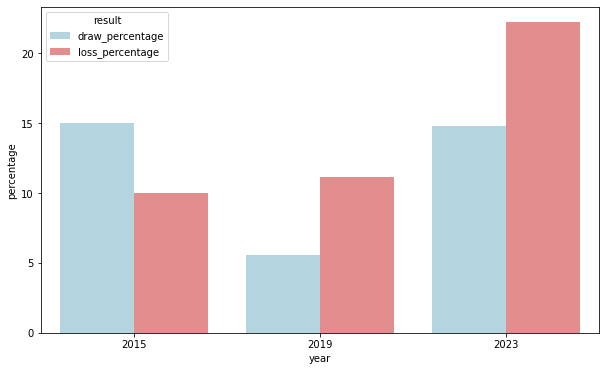 |
The percentage of games favourites are losing is also rising steadily, with double the percentage of games with heavy favourites ending with a win for the minnows in 2023 compared to 2015 and 2019.
Are results more unexpected than previously?
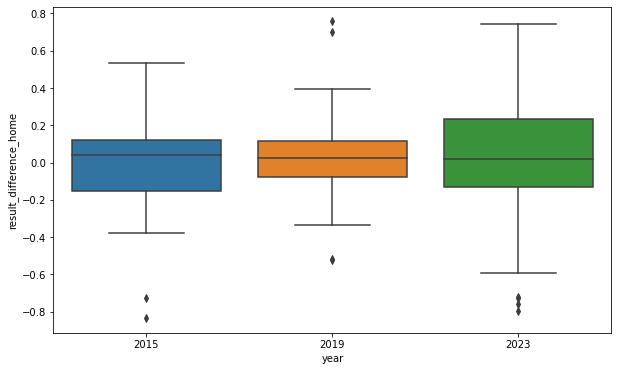 |
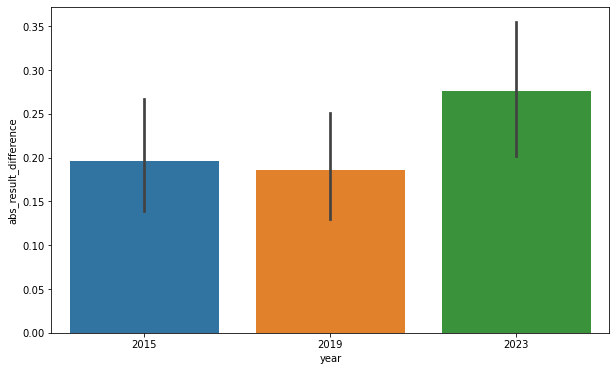 |
There is a larger spread of result differences compared to both 2015 and 2019, meaning the results in the games in 2023 are more unexpected than previously.
 |
If we define an unexpected result as one where the result difference is greater than 0.4, then we have more than doubled the percentage of unexpected results in the group stages since 2019, while this rate was unchanged between 2015 and 2019.
The least expected results of 2023
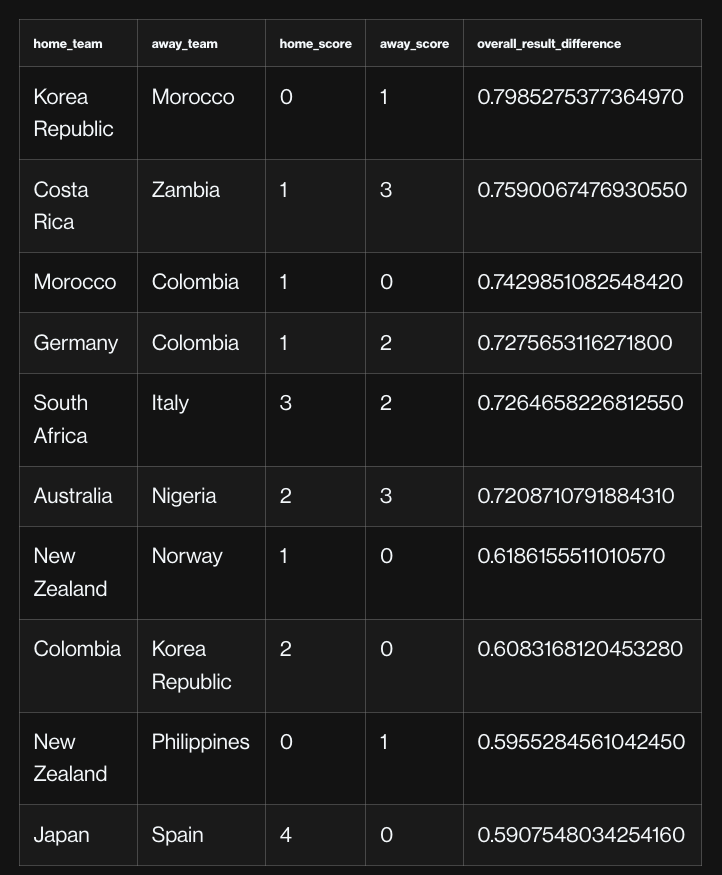
Group H was the most unexpected group with 4 of the Top 10 least expected results occurring in this group. Other notable fixtures were Japan’s 4-0 rout over Spain. Despite both being amongst the favourites (making it difficult to accumulate a large results difference) the win was the 10th most unexpected in the tournament so far. Not an upset, but certainly a very unexpected result.
Over and Under performing teams
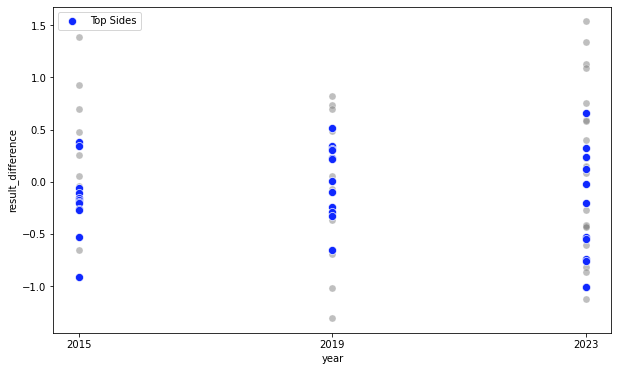 |
This plot shows the “result difference” from every group stage team in each of the last world cup. The result difference shows the sum of the difference between the actual and expected results at the world cup. Teams that perform better than their ranking suggests will have a positive result difference, while teams with poor performances (relative to their ranking) will have a negative result difference. A result difference of about 0 shows teams that have performed approximately as their ranking would suggest.
The above plot shows the results difference of every team at the world cup and highlights the top ranked teams in the world cup (USA, Germany, England, Spain, Netherlands, Sweden, Japan, Canada, Norway, France, Brazil and Australia). In 2015 most of these favourites performed approximately to their expectation. In 2019 the spread of teams was greater, but still most sides played to their ability with only a few standout over and under performers. In 2023 this spread far greater. There are a number of the favourites considerably underperforming their expected performances, with a handful of overperformances.
Which sides have over/under performed?
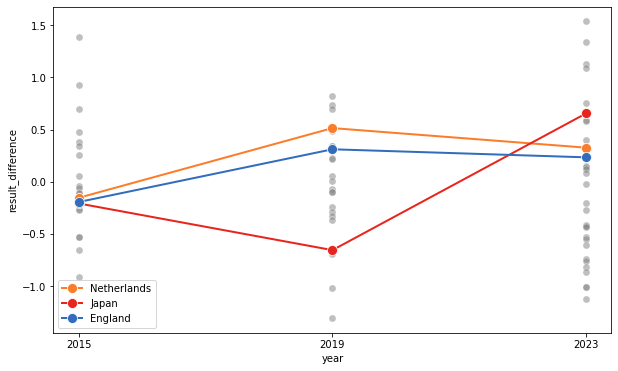 |
Japan have most overperformed their ranking of 11th. England and the Netherlands are also outperforming their Rankings after the group stages. Netherlands seem to be peaking at the right time yet again, showing a similar level of early-tournament overperformance to 2019 when they made the world cup final. England also appear to be overperforming similarly to 2019 when they finished 3rd. They are also the highest rated of this top tier which may make them favourites post group stages.
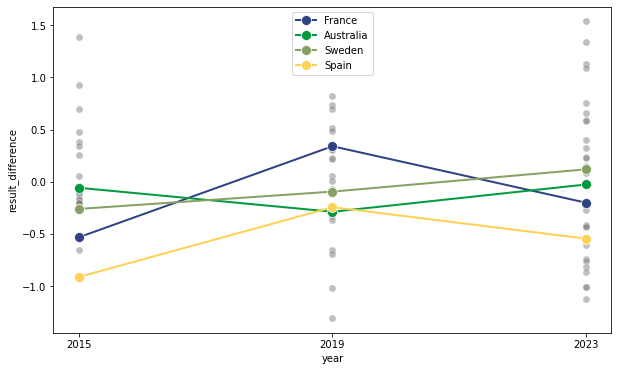 |
France, Australia, Sweden and Spain are the middle pack of performers after the group stages, roughly performing at the level of their rankings. France have fallen back after their overperformance in 2019 when they were hosts – Australia do not seem to be enjoying the same level of home field advantage however. France are the highest ranked side of this group.
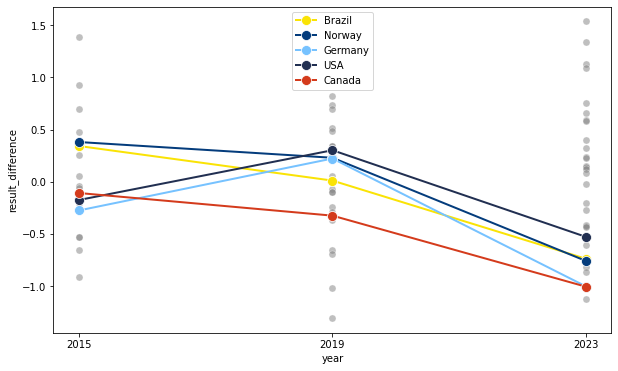 |
Unsurprisingly, by not making it out of their groups, Germany, Canada and Brazil are the lowest performing sides of the favourites. Germany suffered a big upset at the hands of Columbia, losing 2-1 to a side that they would have been expected to beat by at least two clear goals. According to the rankings, Nigeria was Canada’s easiest game of the 2023 group stages, but they drew 0-0. The 10th most certain game of the 2023 group stages was Brazil beating Jamaica, but they only drew.
The USWNT also had a poor group stage, their draw with the Netherlands being over a poor result for them, while their 0-0 draw with Portugal was classified as an upset.
What can be done?
Every coach would say “treat every opponent the same, prepare the same” but fundamentally players do treat teams they see as a lesser threat differently. It places greater importance on having a systematic approach to match preparation – harnessing all the available data together in one place so that decisions are not made in silos, and complacency is not allowed to creep in.
We also know the gap between the top teams and the rest has closed considerably in the last few years (see Stephen’s previous blog post) so the upsets may not be as big as they seem on paper. Many countries have soccer infrastructure from the men’s game that they are now putting into the women’s game, shooting up the quality of previously lower-ranked countries. Indeed it’s quite feasible that the rankings have yet to catch up with the reality of where teams are, and the model behind the rankings needs to be tweaked to reflect the rapidly changing environment in women’s soccer. Right now though, this means that in order for teams to stay ahead of the chasing pack, understanding their opponents – physically, technically, tactically – is more much important, along with ongoing tracking of how their opponents are adapting and modifying their approach as the tournament progresses. Conversely, everyone should assume that their opponents will have been doing the same homework on them. To counteract that, teams should look to adapt their approach so that they are less predictable in future rounds. This may be via their tactical approach, strategic use of substitutions etc.
For instance, upsets tend to be lower scoring games than regular contests, and they are typically decided by one or fewer goals. To avoid an upset, your ability to create chances, convert opportunities and tactically adapt to a defensive set up is going to be more important. Scoring early also is probably a good way to avoid an upset – 53% of upsets in the last three world cups (and 63% of this world cup) have ended with the stronger side not scoring a goal. Only in 21% of upsets have the upset side scored two or more goals (three scored once).
Ultimately that requires an experienced squad and support team that is capable of within-tournament change & adaptation. This capability is one which requires a focus on player development at every level and an ability to track that development against desired outcomes in a systematic manner.




